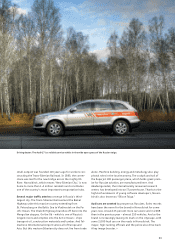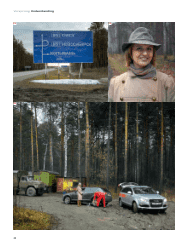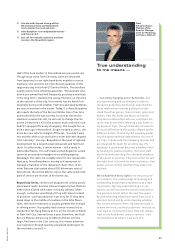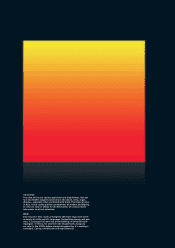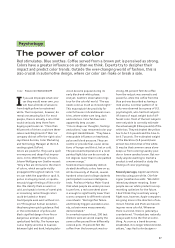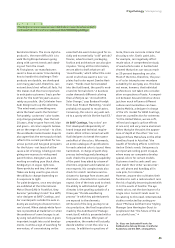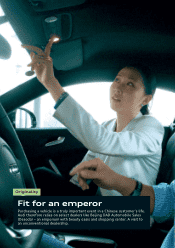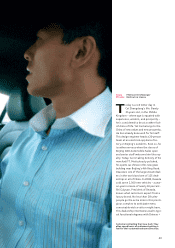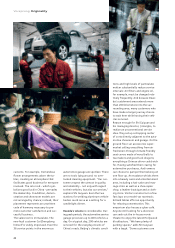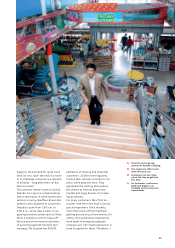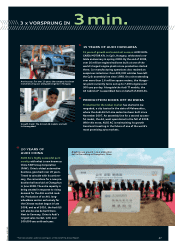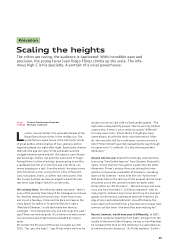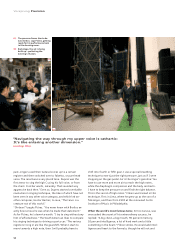Audi 2008 Annual Report Download - page 45
Download and view the complete annual report
Please find page 45 of the 2008 Audi annual report below. You can navigate through the pages in the report by either clicking on the pages listed below, or by using the keyword search tool below to find specific information within the annual report.
4141
Psychology Vorsprung
Sandra Hartmann. The more stylish a
product is, the more difficult it is to
walk the tightrope between going
along with current trends and stand-
ing out from the crowd.
At first glance, car manufacturers
seem to have an easier time deciding
how to handle this challenge: Their
products are durable, are developed
over many years and, therefore, can-
not and should not reflect all fads. Yet
this makes it all the more important
to anticipate customers’ basic prefer-
ences for the next five years as accu-
rately as possible. Ute Grönheim from
Audi Design sums up this dilemma:
“The mind wants something new,
while the heart wants the familiar.”
Fortunately, customers’ color tastes
only change gradually. Over the last
20 years, they’ve gone from red, blue
and green – all colors experts believe
are on the verge of a revival – to silver,
the worldwide market leader. Experts
also agree that the ever-popular black
reflects the current penchant for lux-
urious purism and has good prospects
for the future – not least of all be-
cause a lot of energy is being put into
giving new nuances to widespread
paint finishes. Designers are even
working on making pure black shine.
Ambiguity is in vogue right now.
Nano-particles and tiny, thin metal
flakes are being used to give colors
the ability to change depending on
its exposure to light.
For paint designers, once new designs
are exhibited at the International
Motor Show (IAA) in Frankfurt, they
become “yesterday’s trend.” Eva Höfli,
color designer at BASF Coatings, and
her counterparts outside the auto in-
dustry are working to discover tomor-
row’s trend. When stately-white furni-
ture is presented at trade fairs or when
the ambience of some lounges is set
by using red and brown tones, it gives
important insight into social develop-
ments. Is white a sign of searching for
new values, of concentrating on the
essential? Are warm tones good for so-
cially and economically “cold” periods?
Movies, advertisement, packaging,
fashion and architecture can also give
impulse. “Using all this information,
we are able to draft what we call
‘mood boards,’ which reflect the color
world in which we want to live,” ex-
plains Audi color expert Sandra Hart-
mann. “Trends must be translated
into the Audi brand, the specific mod-
el and its formal idiom.” A business
sedan demands different coloring
than a lifestyle car. “An Audi A8 in
Solar Orange,” says Barbara Hondyk
from Audi Product Marketing, “would
probably not appeal to most tastes.
Conversely, this color is very well suit-
ed to a sporty vehicle like the Audi S3.”
At BASF Coatings, “key colors” are
first developed independently of
brand image and technical require-
ments. Work is then carried out with
Audi designers to tweak the nuance
and effect of the colors. Afterwards,
an entire catalogue of specifications
for each selected color is issued. Hans
Carstensen, in charge of paint shop
process technology and planning at
Audi, checks the processing capability
of the paint lines aided by a team of
chemists, engineers and material sci-
ence experts. His complex tests also
check for scratch resistance and re-
sistance to damage from stones and
chemicals – characteristics customers
expect. One of the tests used to check
the ability to withstand all types of
climates is the grueling sunbath of a
three-year “Florida weathering
process” in which key painted panels
are exposed to the elements.
At the end of the long journey to se-
ries production, the final inspection is
made by the Audi Board of Manage-
ment itself, which is presented with a
fully painted vehicle. After years of
preparation, the market will actually
decide whether or not the color is a
success. In addition to questions of
taste, there are concrete criteria that
also play a role. Exotic paint jobs,
for example, can negatively affect
resale value. A comprehensive study
of used vehicle sales in Switzerland
showed that prices can vary as much
as 20 percent depending on color.
Most of the time, therefore, the pow-
er of color triumphs over mundane
suitability for everyday use. This does
not mean, however, that individual
preference is not taken into consider-
ation on questions of taste. A compari-
son between Asia and America shows
just how much influence different
cultures and mentalities can have.
Sandra Mathia, a designer in charge
of the U.S. market for BASF Coatings,
observes a predilection for extremes:
“In the United States, we see soft,
refined and organic surface effects
at one end, and very coarse aluminum
flakes that give the paint the appear-
ance of depth at the other.” Her col-
league Chiharu Matsuhara on the other
hand has found in Asia that “the
wealth of finishing effects is still lim-
ited on China’s roads. Uniqueness is
an important selling point in Japan,
where many car companies develop
special colors for certain models.
Customers tend to seek small cars
that match their other ‘accessories’:
car, cell phone and handbag all in
cute pink, for instance.”
However, anyone who cultivates their
fondness to such a radical extent runs
the risk of quickly becoming bored with
it. In the words of Goethe: The eye
needs colors, not the dominance of a
single color. Current trends seem to
be catering to this need. International
studies conducted by coating pro-
ducer PPG have led their Color Styling
Manager Jane Harrington-Durst to
prophesize that “the future of the car
is a colorful one.”
Dr. Klaus von Seckendorff works for
Süddeutsche Zeitung Wissen, Frankfurter
Rundschau and Die ZEIT, among others.
COLORS MAKE CARS
P
P
a
a
i
i
n
n
t
t
i
i
n
n
g
g
a
a
c
c
a
a
r
r
i
i
s
s
a
a
c
c
o
o
m
m
p
p
l
l
e
e
x
x
p
p
r
r
o
o
c
c
e
e
s
s
s
s
.
.
W
W
h
h
a
a
t
t
d
d
o
o
e
e
s
s
i
i
t
t
l
l
o
o
o
o
k
k
l
l
i
i
k
k
e
e
w
w
h
h
e
e
n
n
a
a
n
n
A
A
u
u
d
d
i
i
i
i
s
s
d
d
r
r
e
e
s
s
s
s
e
e
d
d
u
u
p
p
?
?
F
F
i
i
n
n
d
d
o
o
u
u
t
t
h
h
e
e
r
r
e
e
:
:
w
w
w
w
w
w
.
.
a
a
u
u
d
d
i
i
.
.
c
c
o
o
m
m
/
/
a
a
r
r
2
2
0
0
0
0
8
8
/
/
p
p
s
s
y
y
c
c
h
h
o
o
l
l
o
o
g
g
y
y




